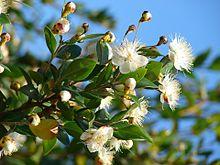| Myrtus communis | |
|---|---|
 | |
| Scientific classification | |
| Kingdom: | Plantae |
| Clade: | Tracheophytes |
| Clade: | Angiosperms |
| Clade: | Eudicots |
| Clade: | Rosids |
| Order: | Myrtales |
| Family: | Myrtaceae |
| Genus: | Myrtus |
| Species: | M. communis |
| Binomial name | |
| Myrtus communis L. | |
| Synonyms[1] | |
| List
| |
Myrtus communis, the common myrtle or true myrtle, is a species of flowering plant in the myrtle family Myrtaceae. It is an evergreen shrub native to southern Europe, north Africa, western Asia, Macaronesia, and the Indian Subcontinent, and also cultivated.[2]
It is one of the four species used in the Jewish festival of Sukkot.
For uses, see Myrtus.
Description
The plant is an evergreen shrub or small tree, growing to 5 metres (16 ft) tall.[3] The leaves are 2–5 centimetres (1–2 in) long, with a fragrant essential oil.[3]
The flowers are white or tinged with pink, with five petals and many stamens that protrude from the flower.[3] The fruit is an edible berry, blue-black when ripe.[3]
Myrtus communis is known for its medicinal properties. It has been widely used as an anti-inflammatory reagent. The essential oils derived from this plant has anti-proliferative properties, helping against food spoilage.[4]
This species[5] and the more compact M. communis subsp. tarentina[6] have won the Royal Horticultural Society's Award of Garden Merit.[7] They are hardy but prefer a sheltered position in full sun.
References
- ^ The Plant List: A Working List of All Plant Species, retrieved 13 August 2016
- ^ USDA GRIN Taxonomy, retrieved 13 August 2016
- ^ a b c d Cretan Flora: An illustrated guide to the flora of Crete, retrieved 13 August 2016
- ^ Myszka, Kamila; Sobieszczańska, Natalia; Olejnik, Anna; Majcher, Małgorzata; Szwengiel, Artur; Wolko, Łukasz; Juzwa, Wojciech (June 2020). "Studies on the anti-proliferative and anti-quorum sensing potentials of Myrtus communis L. essential oil for the improved microbial stability of salmon-based products". LWT. 127: 109380. doi:10.1016/j.lwt.2020.109380.
- ^ "RHS Plantfinder - Myrtus communis". Retrieved 10 April 2018.
- ^ "RHS Plantfinder - Myrtus communis subsp. tarentina". Retrieved 10 April 2018.
- ^ "AGM Plants - Ornamental" (PDF). Royal Horticultural Society. July 2017. p. 64. Retrieved 10 April 2018.


